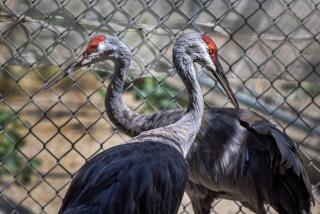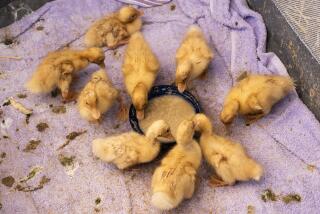Bolinas Lagoon, for the birds
Stinson Beach, Calif.
Something is spooking the egrets and herons.
The lanky white egrets and the bluish-gray herons launch in unison from their twig nests, on the top branches of towering redwood trees overlooking Bolinas Lagoon, just north of San Francisco. The birds soar gracefully, their powerful wings pushing them slowly into the sky.
This is not the kind of thing volunteer Leslie Flint wants to see on opening day at Audubon Canyon Ranch, a nonprofit preserve that has become one of the West Coast’s largest nesting grounds for great blue herons and great egrets.
Flint, a retired schoolteacher and ranch guide, was already worried about the possible effects of November’s oil spill in the San Francisco Bay. Despite efforts by firefighters and fishermen, some of the oil seeped into the mouth of Bolinas Lagoon, washing up on the shores and sticking to birds and ducks.
And as if that weren’t enough, now some kind of predator -- maybe a hawk or raven -- is upsetting the egrets and herons at the ranch.
The herons started to arrive in February, and the egrets showed up a day or two before the March 15 seasonal opening of the ranch.
Flint looks up from beneath her faded orange baseball cap and assures me that the birds will return. She has been a volunteer here for 36 years, so she speaks from experience. But this is no ordinary opening day, as we learn later when the predator that is spooking the birds comes into sight.
Lugging binoculars and a spotting scope, I arrived on opening day to see what effect, if any, the oil spill would have on the annual nesting season at the ranch. Flint offered to guide me through the 1,000-acre former dairy ranch, about three miles north of Stinson Beach.
In 1962, Martin Griffin, president of the Marin Audubon Society, led an effort to buy the ranch and turn it into a sanctuary, killing plans by developers who wanted to drain the lagoon to make way for homes, shops and a marina. A white Victorian home, sitting at the base of a steep canyon, is the headquarters for the preserve. Two milking barns have been converted into classrooms and exhibit halls.
Flint leads me up the Griffin Loop Trail, a three-mile loop that begins with a sharp climb. (If you visit, wear comfortable hiking boots and prepare for steep climbs along muddy trails.) Just before the trail crests at a spot that overlooks the lagoon, Flint points her spotting scope at a flat-topped redwood. Through the lens, I see six or seven great egrets and at least two great blue herons, perched on nests in the top three layers of branches. These are big birds, maybe 4 or 5 feet tall.
As I stare into the scope, Flint explains the courtship rituals that begin in mid-March each year. The males arrive first, picking out the best nesting sites in the trees. When the females show up a few days later, the males crane their necks, snap their bills and display their nuptial plumage to attract females. This behavior goes on throughout March. “It’s almost like a ballet in the trees,” Flint says.
By April, visitors to the ranch can see pale turquoise-colored eggs, about the size of chicken eggs, in the nests. By May, the chicks hatch and break into a clamor of squawking that echoes throughout the canyon. By June, the chicks are learning to fly and are gone by the end of the month.
Back at the trail, Flint tells me the best vantage point is a wooden platform, called the Henderson Overlook, about half a mile hike up the Griffin Loop Trail. The platform looks down onto the tops of the nests.
But first we step into a redwood building with a flat grass sod roof, designed to conceal visitors behind dark mesh windows. This is called a bird blind, and it allows people to get close-up views of birds eating from feeders. Inside the building, I watch dark-eyed juncos eat seed and humming birds drink nectar syrup.
Just as we step out of the blind, I hear a commotion overhead. About half a dozen egrets and herons launch from the redwood trees about 150 feet above. This time, however, we see what has spooked them. A raven, a red-tailed hawk and an adolescent bald eagle circle behind the egrets and herons, one behind the other, like race cars drafting off each other.
Flint’s eyes widen. “Wow! Did you see the eagle,” she shouts to a group of volunteers standing nearby. “This is a new thing to see a bald eagle here.”
Never mind that bald eagles prey on fledgling egrets and herons. This is a milestone, she says, a sign that the preserve is continuing to thrive and attract rare species from far and wide.
Still excited from the eagle sighting, Flint leads me up a dirt path to the Henderson Overlook, passing a riotous display of spring flowers: purple and pale blue Douglas irises, checkered and maroon mission bells and yellow and white zygadene. Wood fern and wild cucumbers crowd into the path.
At the overlook, about six or seven other visitors peek through spotting scopes, trained on the redwood trees. But there is nothing to see except a thick forest canyon and a lagoon in the distance. It seems the bald eagle has kept the birds from returning to their nests.
Through a spotting scope, I scan the trees. I see something, I tell Flint. In a tall redwood, on a thick branch near the top, a great blue heron sits on a nest. No doubt, a male waiting for a mate. Then, just behind a branch on that same tree, I spot another heron on a nest.
Flint assures me that neither oil spills nor bald eagles will keep the birds away for long. Just wait another few weeks, she says, and the canyon will be so crowded with herons and egrets that the redwoods will look like giant Christmas trees.
And this year, for the first time, visitors may see at least one bald eagle circling the Christmas trees, trying to pick off some of those feathered ornaments.
More to Read
Sign up for The Wild
We’ll help you find the best places to hike, bike and run, as well as the perfect silent spots for meditation and yoga.
You may occasionally receive promotional content from the Los Angeles Times.






